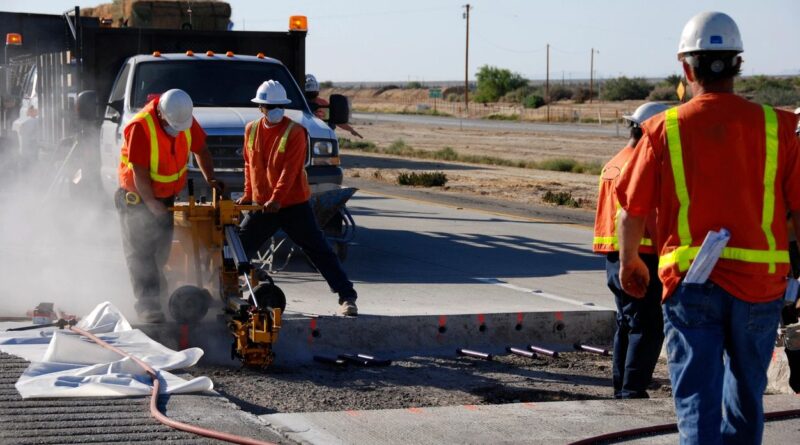Cement Test | How to check quality of cement |cement Field test
Quality Tests on cement are carried out to check the strength and quality of the cement used in construction. It helps to identify the usage of cement for different purposes based on its durability and performance.
Physical Properties of Cement
Due to its binding qualities, cement is a fundamental building material utilized in construction. It is a fine powder that, when combined with water, turns into a paste that solidifies and fuses to build sturdy structures. Cement has the following physical characteristics:
Color
Cement is normally gray in color, however, there may be subtle variations based on the additives and composition employed.
Particle Size
The typical particle size of cement varies from a few micrometers to a few tens of micrometers, making it an extremely fine material.
Density
Cement typically has a density of 3.10 to 3.15 grams per cubic centimeter (g/cm3). However, it may differ based on the kind and makeup of the cement.
Setting Time
When cement and water are combined, a process known as hydration occurs, which leads to the creation of chemical compounds that harden the material. The setting time is the amount of time needed for the cement paste to cure and become firm. Depending on the cement’s composition and the surrounding environment, it can change.
Fineness
The degree of grinding of the cement particles is referred to as fineness. Greater surface area for hydration is provided by finer particles, hastening setting time and boosting strength.
Heat of Hydration
Heat is produced by cement when it hydrates. The quantity of heat generated by this chemical reaction is known as the heat of hydration. Preventing an excessive temperature rise is crucial in large-scale concrete applications.
Porosity
Porosity in cement paste has an impact on the substance’s durability and strength. Higher strength and better water resistance are often associated with lower porosity.
Strength
With time and continued hydration, cement gains strength. Compressive strength, which measures a material’s capacity to withstand crushing pressures, is the most common way to assess a cement’s strength.
Shrinkage
During the drying and hardening process, cement shrinks to a certain extent. In addition to causing cracks, shrinkage can reduce a structure’s overall toughness. Reduced shrinkage-related problems are made possible by using proper curing and building methods.
Durability
The longevity and resilience of cement against weathering, chemical assaults, and other environmental variables are well recognized. However, to guarantee long-term endurance, correct mix design, building techniques, and maintenance are crucial.
Chemical Properties of Cement
Cement has chemical characteristics that affect its performance in addition to physical properties. Among cement’s crucial chemical characteristics are:
Composition
Tricalcium silicate (C3S), dicalcium silicate (C2S), tricalcium aluminate (C3A), and tetra calcium aluminoferrite (C4AF) are the four main constituents of cement. The chemical characteristics of cement are influenced by these chemicals and other minor components.
Hydration
Cement undergoes a process known as hydration when water is introduced. Calcium hydroxide (CH), calcium silicate hydrate (C-S-H), and other minor chemicals are produced as a result of this reaction. The cement hardens and sets as a result of the hydration process.
Retardation and Acceleration
The inclusion of specific chemical components can change how quickly cement sets. The setting time is prolonged by retarding admixtures like lignosulfonates, while the setting time is sped up by accelerating admixtures like calcium chloride. In particular building contexts, these chemical additives can be employed to regulate the cement’s setting time.
Pozzolanic Reactions
Pozzolanic elements like fly ash or silica fume are included in several cement types, including Portland pozzolana cement (PPC). These substances combine with calcium hydroxide to generate extra hydrated compounds that increase the cement matrix’s tensile strength and durability.
Sulfate Resistance
Sulfate-rich conditions can expose cement, such as in sulfate-rich soil or water. Ettringite is produced when the tricalcium aluminate (C3A) component of cement combines with sulfates. Ettringite can lead to expansion and cracking. To lessen sulfate attack, cement compositions with less C3A are employed, such as sulfate-resistant Portland cement (SRPC) or low-heat Portland cement (LHPC).
Alkali-Aggregate Reactivity (AAR)
The alkalis in cement may react with certain of the aggregates used in concrete, causing expansive reactions and subsequent cracking. The term “alkali-aggregate reaction” (AAR) refers to this event. AAR danger is reduced by using cement with low alkali concentrations, such as low-alkali Portland cement (LAPC).
Carbonation
Concrete constructions can eventually become permeable to atmospheric carbon dioxide, which reacts with calcium hydroxide to generate calcium carbonate. This procedure, known as carbonation, lowers the concrete’s alkalinity and may have an effect on its durability, particularly when moisture and carbon dioxide are present.
Chemical Additives
Cement compositions may be altered by adding a variety of chemical additives to change its qualities. These additives include plasticizers, superplasticizers, air-entraining agents, accelerators, retarders, and waterproofing agents. Plasticizers are substances that lower the amount of water in a substance. These additives change the cement paste’s rheology, workability, setting time, and other properties.
Leaching and Efflorescence
In some circumstances, water can drain alkalis, sulfates, and other soluble substances from cement, changing the cement matrix’s composition and characteristics. Additionally, the migration of these substances to the surface may lead to the development of efflorescence, a crystalline deposit that is white in color.
Chemical Stability
When correctly manufactured and dried, cement demonstrates chemical stability throughout time. It can withstand chemical assaults from acids, alkalis, and other strong compounds. However, exposure to harsh chemicals or extreme weather over an extended period of time can weaken the cement matrix and reduce its endurance.
Types of Cement Tests
The following tests are conducted on cement in the laboratory as per IS 4031 – Cement Test
- Setting Time Test of Cement
- Fineness Test of Cement
- Soundness Test of Cement
- Consistency Test of Cement
- Heat of Hydration Test of Cement
- Specific Gravity Test of Cement
- Compressive Strength Test of Cement
- Chemical Composition Test of Cement
1. Setting Time Test (Initial and Final Setting Time Of Cement Test)
The first setting time of cement provides a general sense of how quickly cement may begin to lose its plasticity, while the ultimate setting time of cement provides a general indication of how long cement needs to lose all of its fluidity and develop some strength to withstand pressure.
Initial Setting Time of Cement: The Initial setting time of cement is the period of time from the addition of water to the cement until the paste begins to lose its plasticity.
Final Setting Time of Cement: This is the amount of time that has passed between the addition of water to the cement and the point at which the paste has become sufficiently solid to withstand a specific amount of pressure.
IS Code
According to IS: 4031 (Part 5), Utilizing a VICAT device that complies with IS: 5513 – 1976, the initial and ultimate setting times of cement are computed.
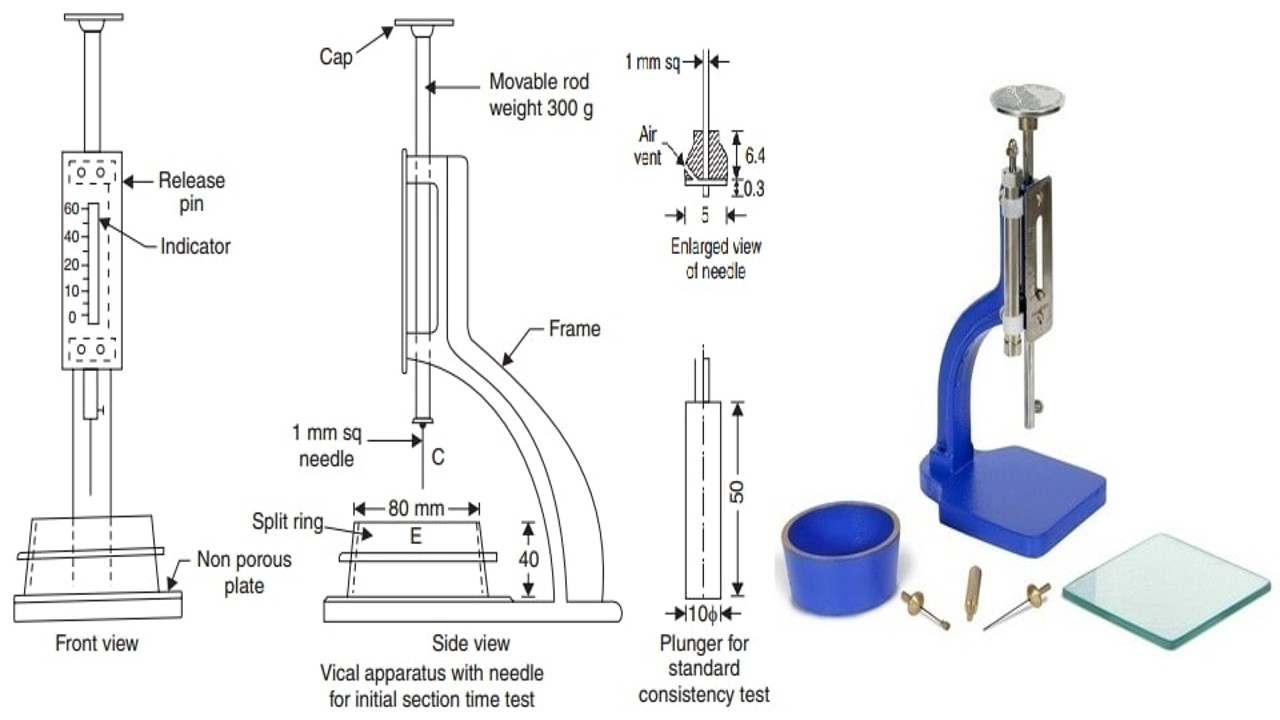
Apparatus
- Vicat Apparatus
- Enamel Tray
- Gauging or Mixing Trowel
- Glass Plate
- Balance
- Stop Watch
Test Result
For OPC cement, the Initial setting time should be shorter than 30 minutes in accordance with specifications. For OPC cement, however, it shouldn’t be longer than 600 minutes.
2. Fineness Test
The specific surface area of cement is used to express the fineness of cement, which is a measure of cement particle size. Cement sample separation for the test is carried out using an IS standard sieve.
Calculations are used to determine the weight of cement particles larger than 90 microns and the proportion of retained particles. This is referred to as cement’s fineness.
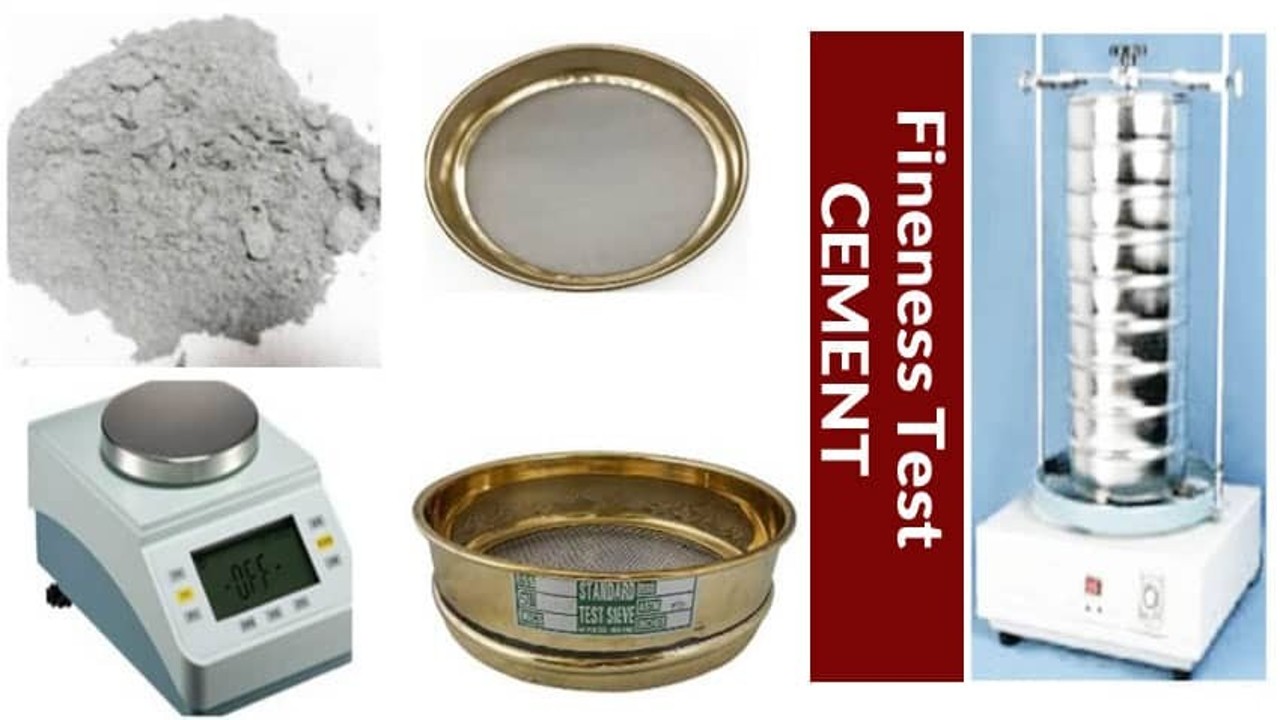
Apparatus
90µm IS Sieve, Weight Balance having a capacity of 10mg to 100g, Nylon or pure bristle brush.
IS Code
Determining the fineness of cement by using a 90 µm IS sieve is done as per IS 4031 (Part 1) – 1996.
Test Result
The standard value of fineness of cement should have a fineness of less than 10 % or fineness should not be more than 10% as per IS Recommendations.
3. Soundness Test
The stability of any cement throughout the volume change during the setting and hardening processes is indicated by the soundness of the cement.
After setting and hardening, if the volume change in cement is unstable, the concrete element can crack, which can lower the quality of the building or possibly result in major accidents. This is referred to as having poor dimensional stability.

Apparatus
- Le-Chatelier mould
- Cement, Glass sheets
- Mixing pan
- Trowel
- Weight
IS Code
IS Code for the soundness test of cement is IS: 4031-Part 3-1988
Test Result
The soundness calculated L1 – L2 for the types of cement Ordinary or OPC, Rapid, Low Heat, PPC, and High alumina cement should not exceed 10mm.
4. Consistency Test
The proportion of water supplied in 300gm weights of cement that allows a Vicat plunger with a 50 mm length and 10 mm diameter to pierce cement paste to a depth of 33–35 mm from the top of the mold is considered the standard consistency of cement paste.
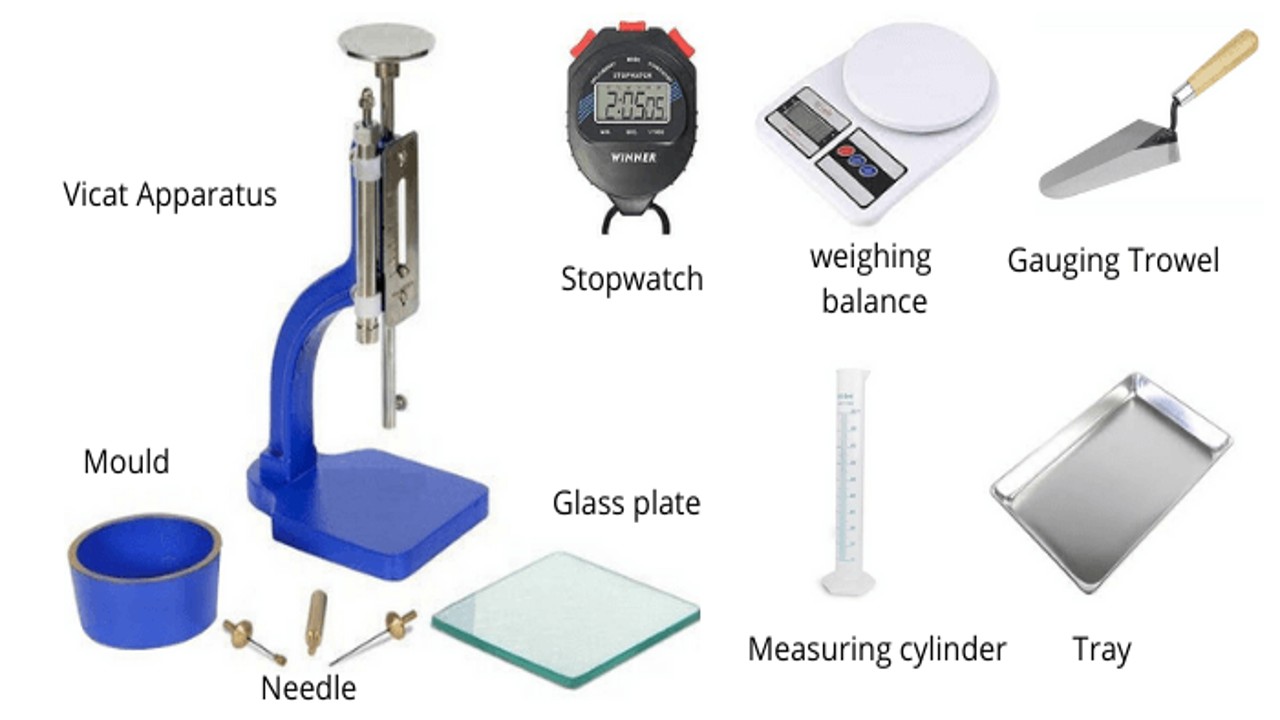
Apparatus
- Vicat apparatus
- Balance
- Gauging Trowel
- Stop Watch, etc.
IS Code
Consistency Test of Cement IS Codes – IS: 5513-1976, IS: 4031 ( Part 4 ) – 1988
Test Result
The Standard consistency of cement paste generally varies between 25-35%.
5. Heat of Hydration Test
The hydro-thermal reaction that occurs during the curing of concrete causes chemical reactions that produce heat. Concrete may experience temperature increases of up to 50oC.
Low-heat cement is thus utilized to minimize this heat. Using a calorimeter and the concept of heat gain, the test is run.
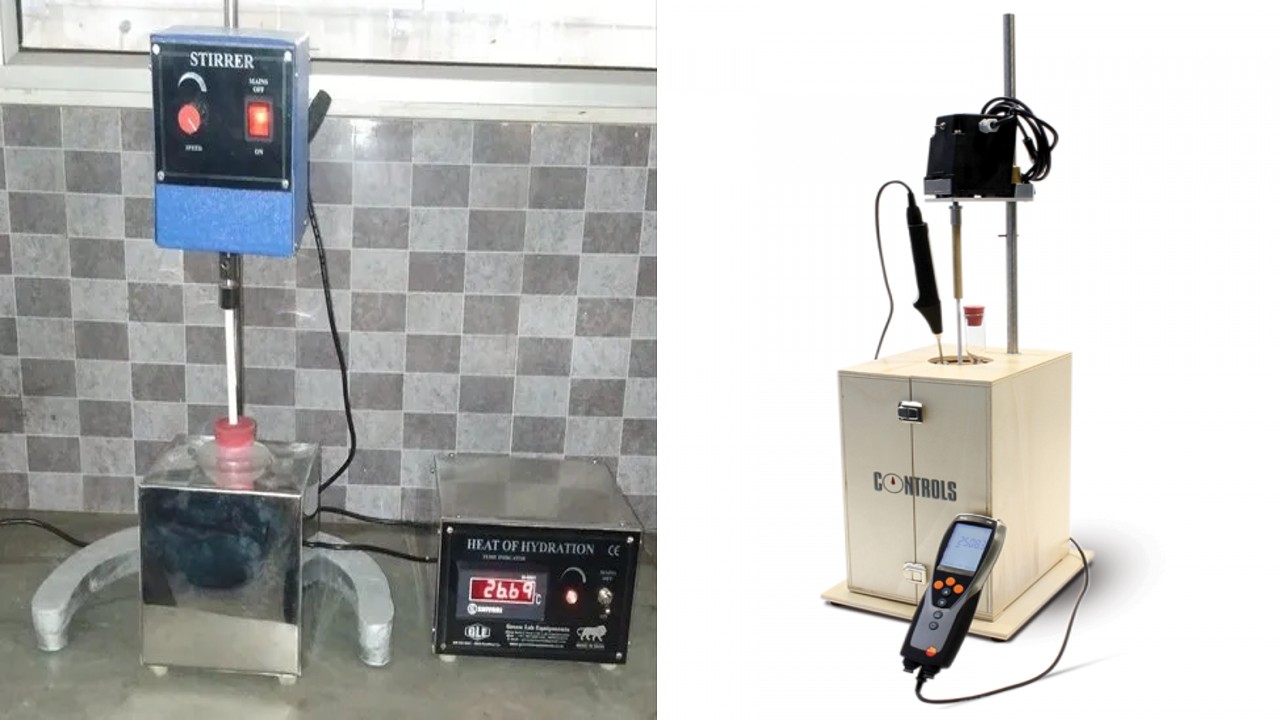
Apparatus
- Calorimeter
- Insulated wood case
- Thermometer plus holder
- Vacuum jar with stopper
- Glass funnel
- Stirring paddle
- Chuck
IS Code
IS 4031-1968 (Part-9) is recommended for testing the heat of hydration of Cement.
Test Result
According to standards, low-heat cement shouldn’t produce more heat than 65 calories per gram in a week or 75 calories per gram over the course of 28 days.
6. Specific Gravity Test
The amount of cement in a given volume divided by the mass of water in the same volume is known as the specific gravity of cement. It may alternatively be described as the ratio of cement density to water density for a given volume.
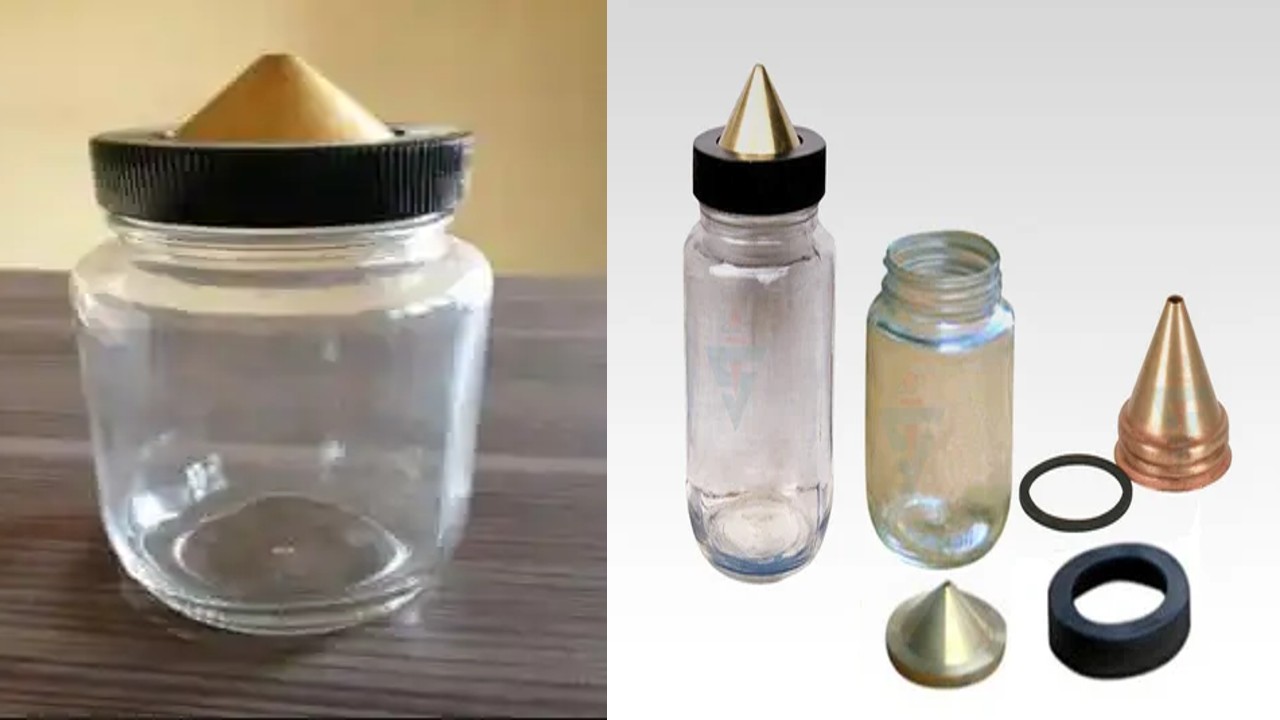
Apparatus
- Le Chaterlier flask
- Weighing balance
- Kerosene (free from water).
IS Code
IS code for Specific Gravity Test is IS 2720- Part 3, IS 4031 Part-11
Test Result
Cement has a specific gravity of 1440 kg/m3. The Specific Gravity of Cement is regarded as being standard and adequate for building around this amount.
7. Compressive Strength Test
The greatest load that cured cement can support without breaking under stress is known as its compressive strength.
The tensile strength of cement must be tested because different types of applied loads can induce tensile cracking in concrete buildings, which is a serious problem. Tensile strength is significantly less than compressive strength.
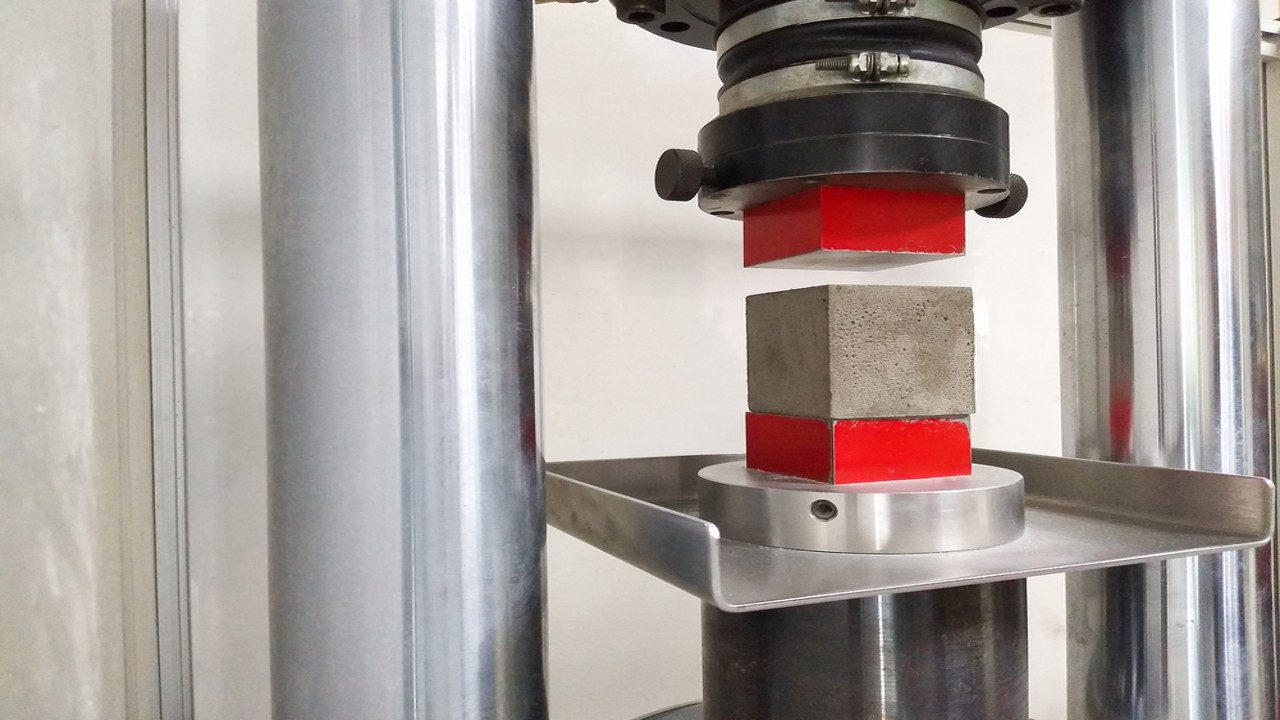
Apparatus
- Testing Machine
- Tamping Rod
- Concrete Mould
- Trowel
IS Code
IS 4031 (Part-6) gives the formula for calculating the compressive strength of concrete.
Test Result
The Tensile Strength of Cement is between 3-5 MPa i.e 300 – 700 psi.
8. Chemical Composition Test
Lime or limestone, silica (SiO2), alumina (Al2O2), magnesia (MgO), and other materials are included in cement to make cement as a finished product. Limestone, clay, and marl are three of the most crucial raw ingredients used to make cement.

Apparatus
- Flame Photometer
- ELE Flame Photometer
IS Code
IS 269-1998 is recommended for keeping a check on the chemical composition of cement.
Test Result
A good cement should have the constitution of components as listed,
- Lime or Limestone – 62% (Highest)
- Silica (SiO2) – 22%
- Alumina (Al2O2) – 7.5%
- Magnesia (MgO) – 2.5 %
- Other Components – remaining 6%

